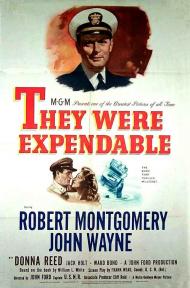Movie Review
Back to Bataan
The Story of the Invisible Army of the Philippines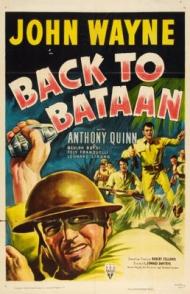
US Release Date: 05-31-1945
Directed by: Edward Dmytryk
Starring▸▾
- John Wayne, as
- Col. Joseph Madden
- Anthony Quinn, as
- Capt. Andres Bonifacio
- Beulah Bondi, as
- Bertha Barnes
- Fely Franquelli, as
- Dolici Dalgado
- Richard Loo, as
- Maj. Hasko
- Philip Ahn, as
- Col. Coroki
- Alex Havier, as
- Sgt. Bernessa
- Louie, as
- Maximo Cuenca
- Lawrence Tierney as
- Lt. Cmdr. Waite
![3 star[s] out of 4](http://www.threemoviebuffs.com/static/images/global/featured_gold_stars.png)
![3 star[s] out of 4](http://www.threemoviebuffs.com/static/images/global/featured_gold_stars.png)
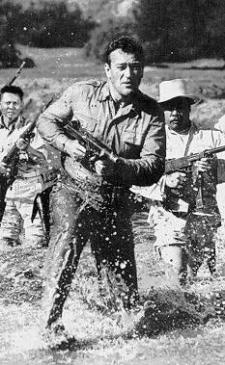
John Wayne in action.
Back to Bataan plays like a sequel to They Were Expendable, which ends with American service men being left behind in the Philippines when it gets overrun by the Japanese. Back to Bataan is about a colonel who stays behind and organizes a Filipino guerrilla movement to fight the Japanese until the U.S. military makes it’s return in a big climactic battle.
Wayne plays Colonel Madden with, oh who am I kidding? Wayne does not play anyone but Wayne. God love him, but the man never really played a character, he just played himself. Wayne was larger than life and no actor has ever come close to equaling his screen presence. When the Duke is on the screen, there is no one else.
In the supporting cast is Anthony Quinn as the grandson of a long dead Filipino leader. Wayne rescues him to help motivate the citizens to fight. Quinn is in love with a woman who has been recruited by the Japanese to spout propaganda over the radio to convince the Filipinos to surrender.
Speaking of propaganda. This movie, although full of action, is pure political bias on every level. Early in the movie, a teacher asks her young Filipino students what the Spanish brought to them when they first conquered them. One studious girl stands up and says, politely, Christianity. Then the teacher asks what did the Americans, who were occupying the Philippines at the time, bring to them. The children erupt with gleeful answers like, “Movies!” and “Baseball!”
The propaganda really gets thick in some of the dialogue. Quinn’s girlfriend says to him at one point, “We don’t want freedom as a gift. We want it as a right to something we fight and die for.” Another scene has the teacher holding a dying student in her arms after he just saved the guerrilla band from an attack. The boys last words are, “I am sorry I didn’t learn to spell liberty.” To which the sobbing teacher responds, “Dear God, whoever learned it so well?”
But alas this is a John Wayne war movie and the action and suspense are plentiful. One great scene has Wayne lying on the ground when a bomb goes off near him, sending him flying through the air. I watched the scene several times because it looks so good. It all happens in one frame and it really looks as if Wayne was blown away. Another scene that sticks with me is when the leader of the Japanese is talking to his officers, and Quinn’s girlfriend, about how they can beat the guerrillas. While he talks he is holding a knife with the sun light reflecting off it and onto the necks of those he is addressing.
Back to Bataan is a great old war film, occcasionaly bogged down by some over-the-top pro American messages. Do not get me wrong, I am a huge patriot, but subtle this movie ain't. Fewer lectures disguised as plot exposition would have promoted this to a four star movie.
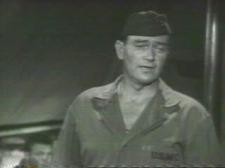
War hero Wayne.
“We don’t want freedom as a gift. We want it as a right to something we fight and die for.” The propaganda in this dialogue didn’t bother me at all because it is realistic. An oppressed person fighting for liberty would very likely utter something like that. It is not propaganda for propaganda’s sake, it also serves to advance the story and heighten the drama.
The cast is good. John Wayne is his larger than life self here and he displays his usual mix of tough-guy gruffness with a kind heart underneath. As in many Wayne movies he leaves the romance to another character and Anthony Quinn handles that job in this one. The great character actress Beulah Bondi plays the stern school teacher with a heart of gold and the relationship between her and the young student Maximo gives the story a poignancy missing from most war movies.
The action scenes, as Eric said, are well done and the movie clips along at a nice pace, clocking in at just over 90 minutes. Modern movies could learn much from the pace of older films. A whole lot of plot and character development was packed into movies then and with a few notable exceptions most of them had running times of less than 2 hours. Action movies today waste far too much time on CGI eye candy that will only seem embarrassingly bad in just a few years time.
Back to Bataan is a rousing, rip roaring, old-fashioned war movie that wears its heart on its sleeve. And what’s wrong with that, I’d like to know?
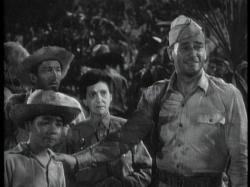
Louie, Beulah Bondi and John Wayne in Back to Bataan.
Talk about ripped from the headlines! This movie was released in May of 1945. It ends with the American invasion of the Philippines that took place just 7 months earlier. In fact, the invasion took place during filming and the script had to be rewritten on the fly to accommodate the changing war news. When the prison of war camp at Cabanatuan was liberated, the filmmakers quickly added that to the movie and used the actual POWs at the beginning and end of the film.
In terms of the patriotic propaganda, I have to side with Eric. It is laid on thick and overdone. The sentiment of it is very fitting, but it's not said in a realistic manner. Nobody talks like that no matter how oppressed they are. Some of the patriotism is actually quite moving, such as when the Filipino man refuses to lower the American flag and is hung for his defiance. It just needed a little more sophistication in the way it is actually said out loud.
Wayne is fairly subdued. He's the big name and it's his movie, but the supporting cast plays a large part as well. Mexican Anthony Quinn has an important role, even though he doesn't look Filipino in the slightest, especially when he's surrounded by Asians. I agree with Patrick that Beulah Bondi is good as the school teacher and while the young boy playing Maximo isn't the greatest actor, he does provide the story's biggest emotional moment.
Some of the action is quite graphic for its time. We don't actually see the body, but there are scenes of Japanese soldiers bayoneting prisoners. In another scene, a Japanese soldier is hit with a thrown machete and it pierces his neck. There's not much blood, but it's still fairly gross.
I wouldn't say this is a great war movie. Parts of it are terrific, but all the different pieces of it never quite add up to perfection. It is however, a very good one and like most John Wayne movies, solidly entertaining.
Photos © Copyright RKO Radio Pictures (1945)

